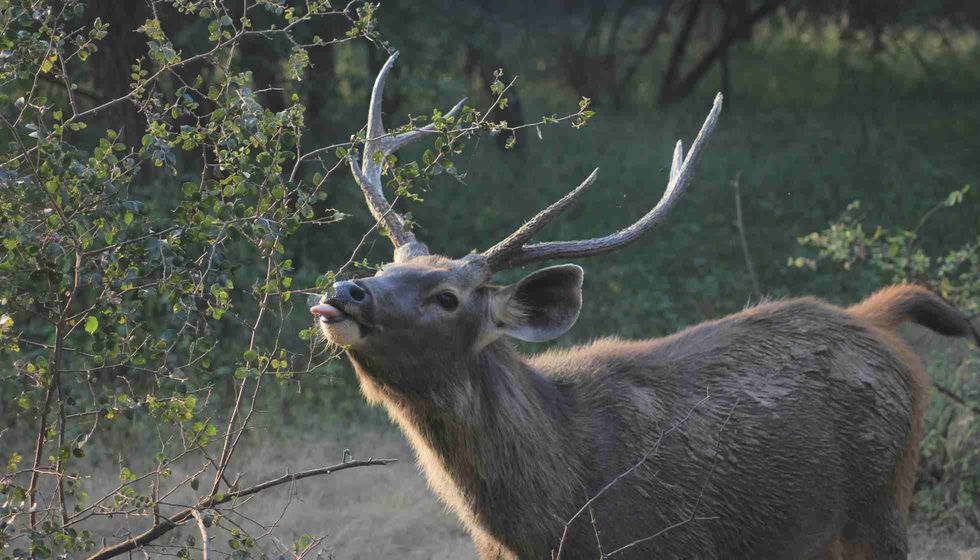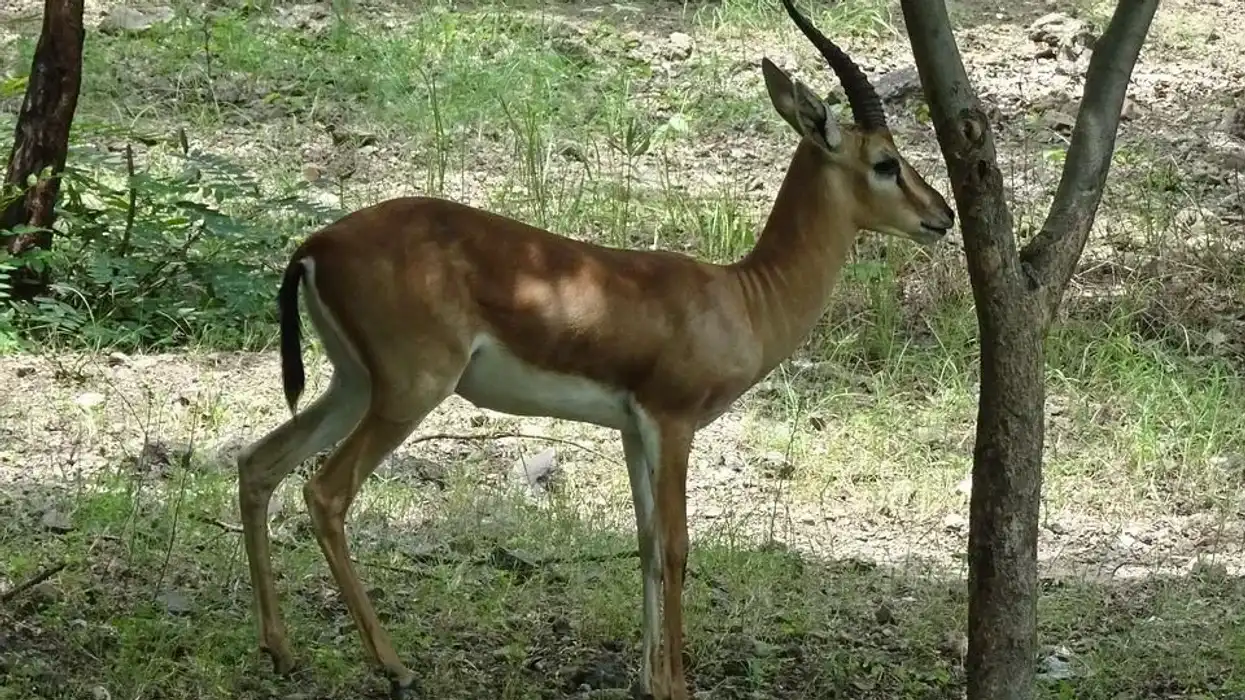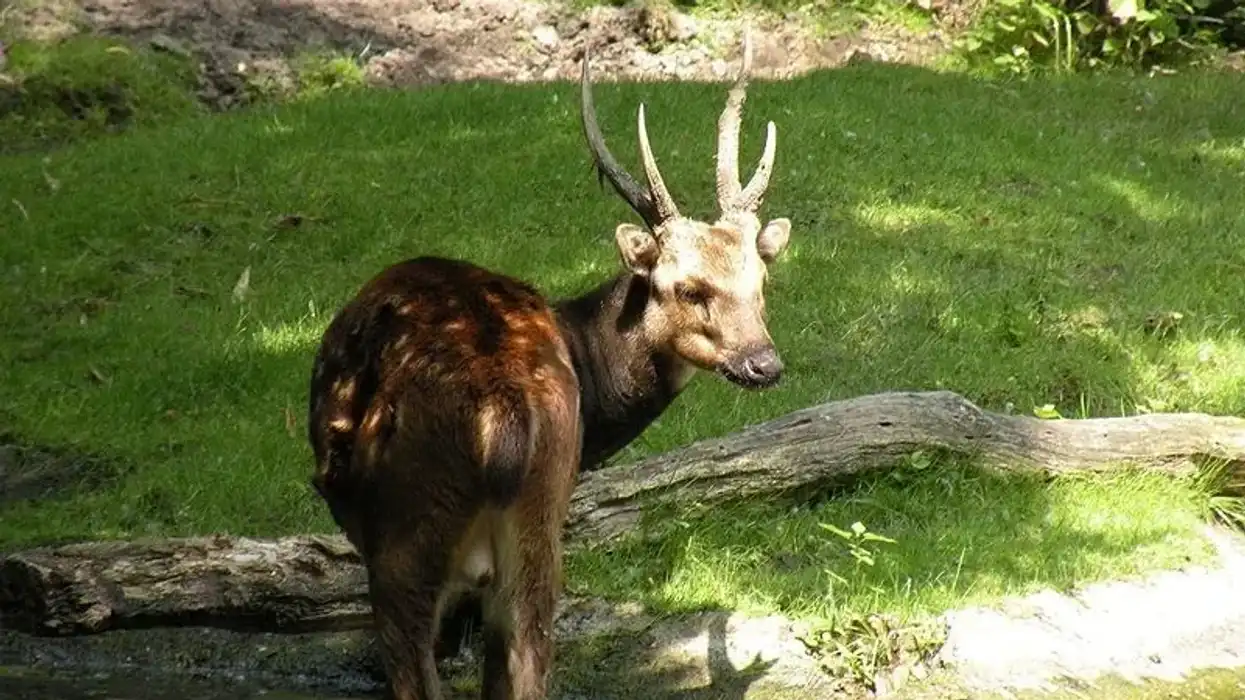The deer, Sambar, Rusa unicolor, is a species of deer found mostly in the Indian subcontinent, Southeast Asia, and South China. These are a species of large deer and are one of the largest members of the deer family. There are over seven subspecies of the Sambar deer.
This species of deer was first considered a part of the genus Cervus and had the scientific name Cervus unicolor. But now, they have been put in the genus Rusa. The scientific name of Sambar deer now is Rusa unicolor.
This species is also known as Indian Sambar, Rusa unicolor, because of their heritage in the range of the Indian continent. This deer species is fairly shy and nocturnal.
They are known to be mainly active in the twilight and at night. Because of the shy nature and alertness of the deer species, they freeze instantly if disturbed. When they sense danger, these species are known to stamp their feet and make a ringing call called 'pooking' or 'belling'.
References from many articles have shown us that the Sambar deer are often a target of hunters for their meat and beautiful antlers. This is one of the reasons for their declining population and needs to be controlled. Read on to learn more, and check out some interesting facts on the Black-tailed deer and Burmilla too.
Sambar Deer Interesting Facts
What type of animal is a Sambar Deer?
The Sambar deer is one of the largest species of deer found in the world.
What class of animal does a Sambar Deer belong to?
The Sambar deer falls under the class of Mammalia in the kingdom of Animalia.
How many Sambar Deers are there in the world?
The total population size of the Sambar deer is unknown at the moment. In India, the population size is said to exceed 50,000 and in Australia, there are more than 5,000 individuals currently. But due to the Sambar deer hunting practices, this population is slowly declining.
Where does a Sambar Deer live?
The seven subspecies of the Sambar deer are found in the South and Southeastern parts of Asia. India, Sri Lanka, Nepal, China, Cambodia, and Thailand are the main originating places of this species.
Other than these places in Asia, a widespread population of Sambar deer is found in Australia, New Zealand, and North America. South-facing slopes of the Himalayas in Nepal and India are also a common natural range of habitat for the Sambar deer.
The population of the Sambar deer in Florida is very limited in the St. Vincent Island area. These animals were imported to St. Vincent Island in the 1900s, and the species survived when the other species imported with them were not so fortunate.
What is a Sambar Deer's habitat?
Mostly found in the wild, the Sambar deer habitat has to include a water body. They are always found near water and in a broad range of forests like dry deciduous forests, rain forests, and mixed forests.
This range of the Sambar deer starts from the Himalayas to the South part of Asia and ends at the islands of Taiwan, Sumatra, and Borneo.
Who do Sambar Deer live with?
The Sambar deers are mostly solitary animals. During breeding seasons, they are found to form groups of six females or fewer. The young too travel with these groups.
Males are mostly solitary after attaining an age of six years or older. The males have no fixed habitat in the wild and the territory is established by the males before the breeding season. The males are also sometimes found in groups of 10 or fewer.
How long does a Sambar Deer live?
The average life span of these wild animals is 20-26 years. The age also depends on the amount of predation they face from the wild foes during the hunt.
How do they reproduce?
The territories are already established by the males. They attract females through vocal displays and smells. The males tend to be very aggressive during the breeding season, which is usually between September and January. Females have a gestation period of about nine months.
Only one fawn (young deer in the first year) is born, and the calves are very active at birth. The females care for the calves for the next two years. The male does not have a bigger role in the nurturing of the calves.
What is their conservation status?
The conservation status of the Sambar deer has been kept as Vulnerable by the IUCN. They are hunted by wild predators and humans alike, for food. They are often found as food items on the menu in places where the species is not protected.
Hunting practices in St. Vincent Island Florida, New Zealand, and Australia have led to much of the decline in numbers of the Sambar deer. The Sambar deer hunt for their antlers, and most importantly the meat has escalated to the locals of New Zealand and other hunting countries to try and protect the species from poachers.
Sambar Deer Fun Facts
What do Sambar Deers look like?
The body of this deer is covered with a dark brown coat, which is sometimes yellowish-brown. Whitish spots and markings can be seen on the lateral side of the body. The male species are darker and have manes on the neck. The tails are long and black.
The antlers on the males are almost 43 in long and are shed every year. Adult males and pregnant females have a hair-free, blood-red-colored spot located halfway down the underside of their throats. The calves have brown bodies with lighter spots.
How cute are they?
The Sambar Deer is a magnificent animal and look beautiful with their huge antlers.
How do they communicate?
They usually communicate with voice and smell.
How big is a Sambar Deer?
The length of the head and body of the Sambar Deer range from 63.6-106.8 in (1.62-2.7 m). The length of the tail is about 8.7-13.8 in. They attain a height of 40-63 in (102-160 cm).
How fast can a Sambar Deer move?
The maximum speed of an average deer is about 50 mph. The speed of the Sambar Deer is quite moderate and increases when being hunted.
How much does a Sambar Deer weigh?
Usually, the weight of the Sambar Deer ranges from 220-770 lb (100-350 kg). They can weigh as much as 1204 lb (546 kg) sometimes.
What are the male and female names of the species?
The male and female sexes of the species are not given different names.
What would you call a baby Sambar Deer?
A young Sambar Deer is called a calf.
What do they eat?
The Sambar Deer is a hardcore herbivore and feeds on different types of leaves, bamboo shoots, grass, and fruit. Their food includes 130-180 different types of plant species.
Are they poisonous?
No, they are not poisonous.
Would they make a good pet?
Deers are not meant to be kept in captivity. To view them, you can visit the enclosures in sanctuaries and parks.
Did you know...
The super Sambar deer facts include their heightened sense of hearing to know about their predators from long-range.
The Sambar Deer in India is found in almost all corners of the country but is mostly concentrated in the central region. Kanha, Corbett, Ranthambore, Bandhavgarh, Gir, Dudhwa, Manas, Kaziranga, and Sariska are some of the parks where the Sambar Deer can be spotted.
Do Sambar Deers lose their antlers?
The Sambar Deer sheds their 40 in long antlers every year.
Are Sambar Deer endangered?
They are not endangered yet. They are a protected species, classified as Vulnerable by the IUCN in 2008.
Here at Kidadl, we have carefully created lots of interesting family-friendly animal facts for everyone to discover! Learn more about some other mammals from our Axis Deer facts and Ankole Watusi fun facts pages.
You can even occupy yourself at home by coloring in one of our free printable Sambar deer coloring pages.










